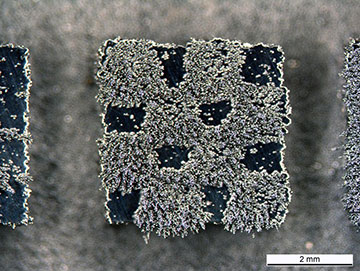
Iron filings stick to magnetized parts of this 4×4-mm mini chessboard. The partly functionalized structure was produced by controlling the speed and velocity of a laser used in a 3D-printing process. [Image: Empa]
By controlling the speed and power of lasers used in 3D printing, a research team in Switzerland reports a method to create novel metal alloys with complex, tailored geometries and functionality (Appl. Mater. Today, doi: 10.1016/j.apmt.2019.100512).
In a proof-of-concept study that the researchers say may be applicable to a range of metal alloys, they used additive manufacturing (AM) to make a 4×4-mm piece of steel alloy with a chessboard pattern of magnetic and nonmagnetic squares. The team includes co-authors Christian Leinenbach, Ariyan Arabi-Hashemi and colleagues at Empa, the Swiss Federal Laboratories for Materials Science and Engineering.
According to Leinenbach, parts much larger than their chessboard are possible. The scientists chose this particular configuration, he says, because it was more easily characterized with a microscope—and they were running of steel-powder starting material.
Stronger than steel
The work, Leinenbach explains, began as a contract research project for a Swiss company that wanted to find ways to use its high-nitrogen steel (HNS) product. This type of stainless-steel, he says, is commercially valuable in part due to its high strength and ductility and resistance to corrosion.
Because HNS uses nitrogen instead of the nickel commonly used in steel alloys, it is also allergy free, Leinenbach says. The metal thus has potential for products that have sustained contact with the body, for example, some medical devices or even jewelry.
But HNS is an exceptionally hard metal and difficult to machine using conventional methods, Leinenbach says. The Empa team, then, set out to develop an AM process for making things with HNS. The challenge was to prevent evaporation of volatile nitrogen because, like nickel, it stabilizes a crystal structure of steel characterized by its nonmagnetic properties.
Stabilizing with nitrogen
Steel comes naturally in two different crystal structures, Leinenbach explains. The so-called ferrite type is magnetic and found in lower-quality construction steel, whereas austenite steel is nonmagnetic and found in stainless steels.
“We need a certain amount of nitrogen to stabilize the nonmagnetic crystal structure,” Leinenbach says. “If the N value is too low, the crystal structure changes to the magnetic one.”
For the AM process, he adds, “We knew there was a very big risk we would lose the nitrogen.” That can happen in both the laser power bed fusion (LPBF) or electron beam melting AM processes, both of which allow layer-by-layer building of parts from powdered-metal starting material, he says.
Controlling volatile elements
The key, Leinenbach says, rests with the so-called melt pool from the powdered metal. The size and lifetime of the pool—that is, the milliseconds it takes for the pool to consolidate—impact the evaporation of nitrogen or other volatile elements and so, too, the alloy’s post-processing microstructure. By adjusting the AM laser’s scan velocity and power, however, the melt pool and nitrogen content of the alloy can be tailored and controlled throughout the build process.
Discovering they could control rather precisely how much nitrogen from the steel was lost in the process—thereby impacting whether the magnetic or nonmagnetic crystal structure was being stabilized—was a complete surprise for the team, Leinenbach says.
“We expected the nitrogen to evaporate,” he says. “The surprise was the magnetism—that we can totally tailor it.”
And it is not just a simple on/off functionality, Leinenbach says. By programming the speed and power of the laser, “We can have a controlled amount of magnetic phase. We can adjust how much magnetism there will be in the final product [and where].”
AM gets real
Leinenbach says it is important to note that “AM has evolved into a real manufacturing technology, especially for products with complex geometries or functionalities.” He offers the example of aero-engine fuel-injector nozzles that have many complex parts. Many manufacturing steps are avoided in making these aero-engine parts today by using AM instead of conventional machining, he says.
A possible application of controlled functionality/magnetic phase with AM, Leinenbach says, might be electric cars. They can be made more efficient either through better batteries or better motors, he says. With an AM process to control magnetic phase, rotor designs could be optimized yielding much greater operating efficiencies than possible with conventional motors, he says.
Future shapes
In terms of other functionalities, Leinenbach says, there is potential for any metal alloy in which a volatile element impacts functionality like magnetism in a phased manner.
He cites nickel-titanium shape-memory alloys with thermo-mechanical properties. These are metals that can be twisted and bent but when dropped in hot water, for example, revert to their original shape. Slight changes in titanium content are the controlling factor.
Leinenbach envisions shape-memory alloys so exquisitely tuned through AM control of titanium content that they could be activated upon insertion in the human body—perhaps with a variety shapes programmed into the LPBF process.
“Alloy composition determines when the shape memory effect will start,” Leinenbach says.
